The engineered products or parts are coordinated between two or more components that move or fit one another to perform their essential functions. To do this, you need to first understand fits and the different types of fits used in engineering.
In this article, we will focus on the different fit types. This relates to the various fit types that you can employ when designing your particular products.
We’ll also cover how to make the right choice of different types of fits. Now let’s get started.
What is a Fit?
You know, every machine has a number of parts. These parts are manufactured separately and then assembled together. There are some parts that move by sliding into other parts, and there are some parts that fit tightly into other parts and move them.
For the smooth functioning of these parts, it is essential that there should be adequate coordination between these parts.
Then this mutual connection between two joining parts is called fit. Simply put, the dimensional relationships between the components are described as a fit. Understanding what a fit is is dependent on knowing a few terms, which are defined below.
Read Also: 16 Types of Measuring Tools and Their Applications
System of Fits
For obtaining various types of fits, the amount of maximum and minimum clearance, either positive or negative, must exist between the mating parts.
From a production and economic standpoint, one of the mating parts’ limit dimensions is fixed while providing tolerance between the two parts. Based on this system of fits, different types of fits are obtained and are broadly categorized into below types.
- Hole basis system
- Shaft basis system
#1 Hole Basis System
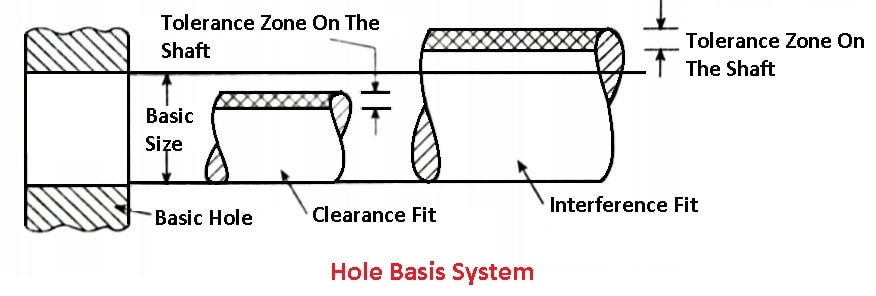
In a hole base system, the hole limit dimensions are assumed to be constant, and a variety of fits are obtained by changing the limit dimensions of the shaft. The following figure shows the clearance and interference fits in the hole basis system.
#2 Shaft Basis System
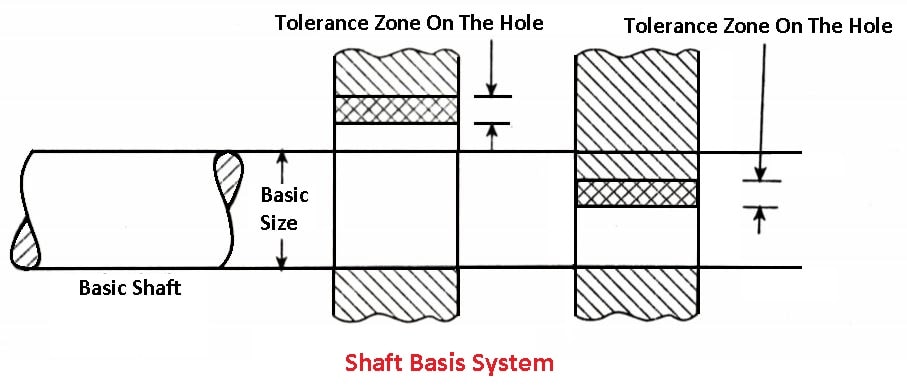
In the shaft base system, the shaft limit dimensions are held constant, and different types of fits are achieved by changing the limit dimensions of the holes. The figure below shows the clearance and interference fits in the shaft basis system.
Reasons For Adopting Hole Basis System
Commonly, the holes are designed by drilling, boring, reaming, broaching, etc. Whereas shafts are either turned or ground.
Suppose a shaft basis system is used to specify the unit dimensions, to obtain various types of fits, a number of holes of different sizes are required, which in turn requires tools of different types of sizes.
By applying the hole basis system, production costs are reduced as only one tool is required to design the hole, and the shaft can also be easily machined to any size. Hence, the whole basis system is preferred when compared to the shaft basis system.
Read Also: What are the types of heat treatment processes?
Fits and Tolerance
Fits and tolerances work together to determine how a product’s components are put together. In order to achieve a successful assemblage, it is imperative to understand both concepts.
The tolerance ranges from the maximum size to the minimum size range. Tolerance is expressed by a number without a sign and has a positive value.
What Mechanical Engineering Terms Define Different Fit Types?
It is crucial to know the terminology used to describe the various fit types because it aids in choosing the appropriate fit types. Also helpful when assembling a product.
An alpha-numeric code identifies a specific fit and indicates its tolerance, according to the International Organization for Standardization (ISO). The hole or shaft is indicated by the alphabet portion of the code.
A lowercase letter is used for the shaft, while an uppercase letter is used for the hole. For instance, based on the letter used, the tolerance range for the shaft (h6) and hole (H7), respectively, is H7/h6.
Engineers will be able to identify the hole and shaft’s maximum and minimum sizes with the help of this code.
Types of Fits
In mechanical engineering, there are different types of fits and each one is created for specific reasons. The ISO specifies three types of fits when manufacturing products.
#1 Clearance Fit
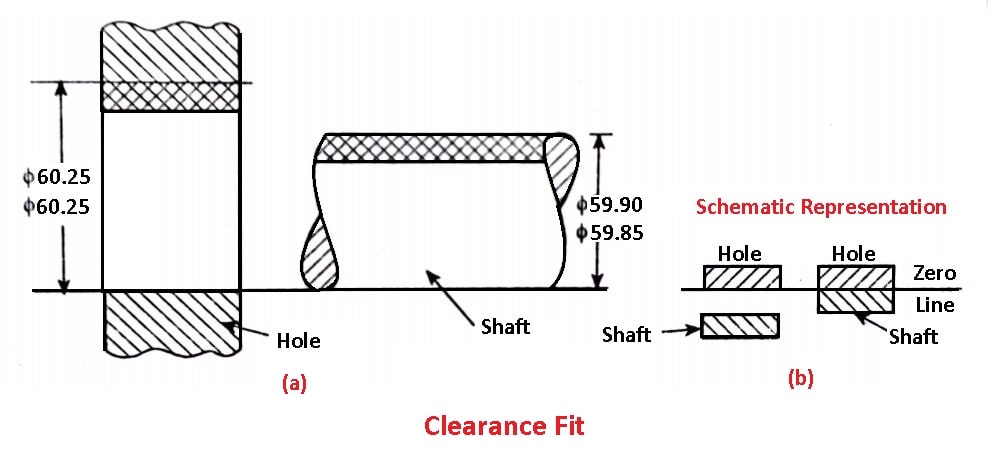
As implied by its name, a clearance fit is employed when loose mating and free movement of the components are required. As a result, they are perfect for creating objects whose components must be simple to slide in and out of.
In this fit, the size of the shaft or male part is kept comparatively slightly less than the size of the hole or female part so that the male part can move in the female part without any obstruction. Running and sliding fits come under the clearance fit.
#1 Sliding Fit
Sliding means “to slip”. In this fit, the male part moves in the female part in a sliding manner. Very little allowance is kept for this fit. More variation is given to it as compared to Running fit.
#2 Locational Clearance Fit
Although locational clearance fits are highly accurate, they can only offer a small amount of clearance.
#3 Running Fit
In these types of fits, there is sufficient allowance between two parts such as shaft and hole that the male part can revolve in the female part with ease. In this fit, the thin layer of lubrication given between the two parts is also taken into consideration.
This fit is used in the shaft, bush, or bearing. The allowance in this fit depends on the part’s diameter, hole, length, and surface. This fit is of three types,
1. Loose Running Fit
These clearance fits are made with the largest clearance and are used where accuracy is not crucial.
2. Free Running Fit
These fits are for applications where the movement of components is required with little regard for accuracy.
3. Close Running Fit
These fits are intended for scenarios where a small amount of accuracy clearance is needed.
Read Also: Types of Screws and Their Uses [Pictures & PDF]
#2 Interference Fit
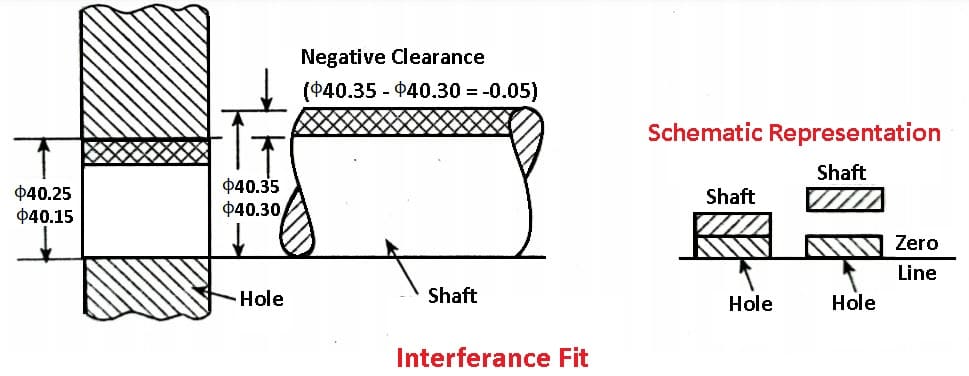
These types of fits involve pressing two components together to fasten them. Many mechanisms are used to fasten the components together, and it takes a lot of force to couple and uncouple them. The mechanism also chooses which types of interference fit to employ.
This fit is quite reverse to the clearance fit. In this type of fit, the size of the male part or shaft is bigger than the size of the hole or the female part. In order to join two parts or to fit them together a great amount of force is used.
For this purpose press machines or hydraulic machines are also used. Force fit and driving fit are included under this fit.
#1 Force Fit
Normally this type of fit is used for round jobs. For example, to fit a shaft in a hole permanently or temporarily. In this fit male part is made slightly bigger or equal in diameter.
It is fitted by putting heavy pressure. A machine press or hydraulic press is used for this purpose, such as a cycle hub or pulley of a motor.
#2 Press or Shrinkage Fit
It is a type of fit, where the female part is kept slightly smaller than the male part. In other words, there is a negative allowance in this fit. In order to fit the male part into the female part, the male part is heated in order to fit it in the female part, by which its volume increases.
The male part is fitted when the female part is in hot condition. In this way, when the female part becomes cool and returns to its normal temperature, it grips the male part permanently.
This type of fitting is done to mount an iron ring on the wheels with wooden spokes. Besides this, the male part can also be fitted by making the male part chilled cold. For example, cylinder liners of motor engines. This fit is called expansion fit.
#3 Driving Fit
In these types of fits, a slight difference is kept between male and female parts. They are fitted by striking them with a hammer etc. It is used in dynamo pulley etc. We can divide this fit into three parts, Light driving fit, Medium driving fit, and heavy driving fit.
Read Also: List of Mechanical Properties [Explained with Examples]
#3 Transition Fit

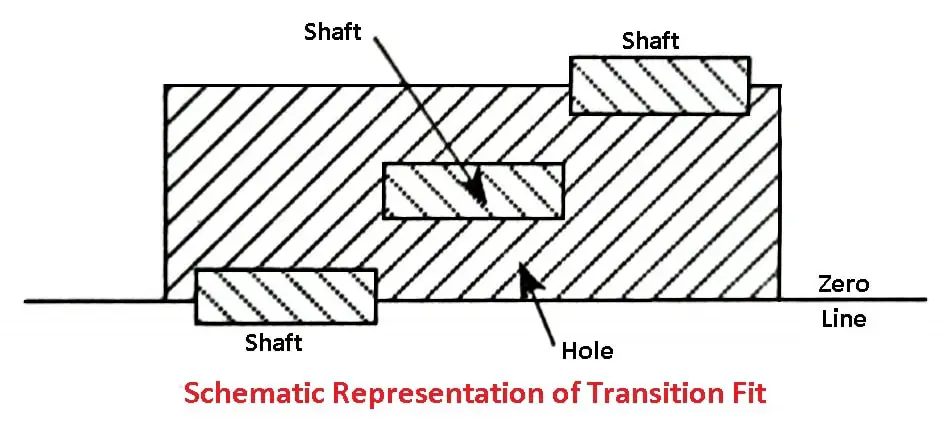
Transition fits are the best option when accuracy is crucial because they sit in between clearance and interference fits. When extreme precision is required for joining mating components, they are ideal.
In this type of fit, the size of the male part or shaft is kept comparatively a bit thicker than the female part of the hole. But the parts of this type of fit can be fitted with some pressure.
They have more clearance than an interference fit when comparing them in terms of the amount of clearance. Still, the clearance is insufficient to ensure joint movement. According to the situation, transition fits either offer clearance or an interference fit.
Push fits and ringing fits come under these types.
#1 Push Fit
In this fit, allowance is kept less than that of running fit. One part is kept stationary while the other part is pushed with a hand or by using a wooden piece and striking it slightly to fit it such as a dowel pin, ring gauge, etc.
#2 Ringing Fit
Ringing means to have friction. In this type of fit, female and male parts are found stuck together. If these parts are to be separated, it can be done only by using pressure. This fit is stationary to some extent.
Read Also: Different Types of Pulleys and Their Uses
Choosing the Right Fit for Your Project
Understanding a number of factors is necessary for selecting the appropriate types of fits for your projects. The key elements you need to be aware of are explained below.
#1 Application
There are types of fits that are best for various purposes, depending on what you need. To select the best fits for a project, compare the accuracy and tolerance displayed by the various types of fits and consider the product’s proposed function.
#2 Tolerance
To select the appropriate fit types for a given product, you must understand the concept of tolerance. Your request must be clear and specific. Additionally, you need to decide whether you want the components to be tight or able to rotate in full circle.
In addition, it is also important to be aware of tolerance slack, which refers to a measurement’s maximum and minimum tolerances. For instance, you must be careful when combining different parts to create a single product. If the resulting tolerance is extremely high, this is crucial.
#3 Budget
You should know your budget before choosing the appropriate types of fits for your products. Utilizing fits with tighter tolerances will be more expensive than usual. As a result, you must carefully consider your options.
As far as product development costs are concerned, it would be best to achieve a fit that provides the right tolerances necessary to perform the functions of the product while reducing development costs.
Conclusion
There are many factors involved in using the various fit types in engineering and utilizing each in various mechanical applications. You will have a complete understanding of a fit and its various types after reading this article.
As part of the article, you also learned what to look for in choosing the right fit for your project. It is more crucial to know how to use a fit than to understand what it does.
So now, I hope that we have cleared all your doubts about Fits. If you still have any doubts about the “Types of Fits” you can contact us or ask in the comments, and I’ll respond.
If you like this article then please share it with your colleagues. You can download the free PDF file of this article by clicking here.
Want free PDFs direct to your inbox? Then subscribe to our newsletter.
You Might Like To Read More In Our Blog: